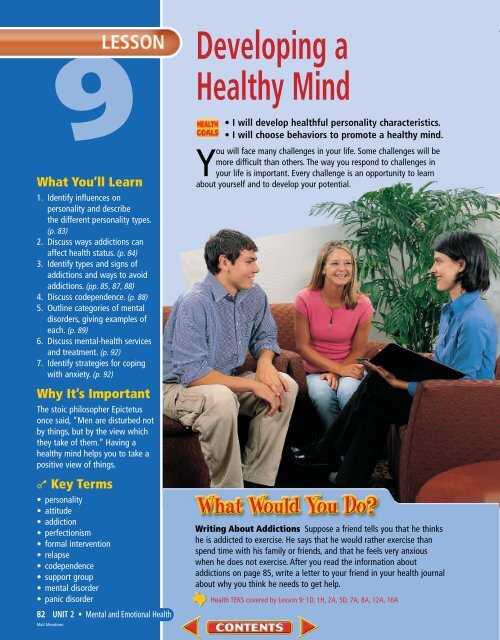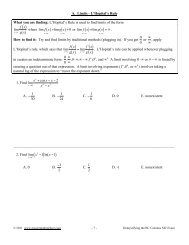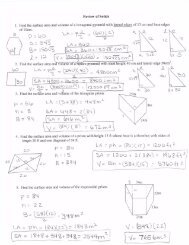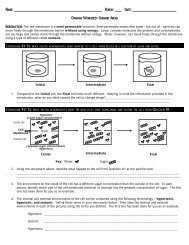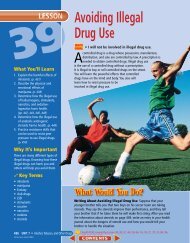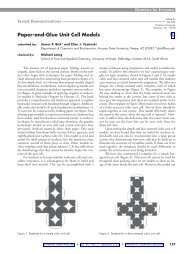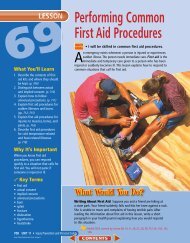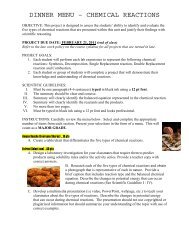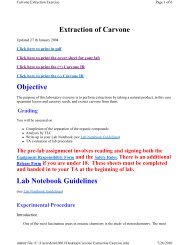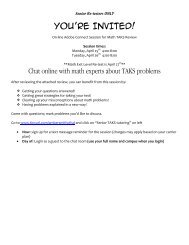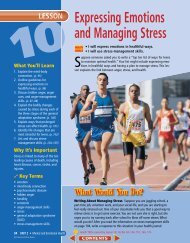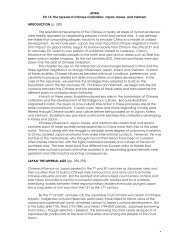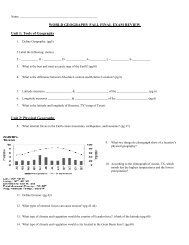Lesson 9 Developing a Healthy Mind - Epsilen
Lesson 9 Developing a Healthy Mind - Epsilen
Lesson 9 Developing a Healthy Mind - Epsilen
You also want an ePaper? Increase the reach of your titles
YUMPU automatically turns print PDFs into web optimized ePapers that Google loves.
Matt Meadows<br />
9<br />
What You’ll Learn<br />
1. Identify influences on<br />
personality and describe<br />
the different personality types.<br />
(p. 83)<br />
2. Discuss ways addictions can<br />
affect health status. (p. 84)<br />
3. Identify types and signs of<br />
addictions and ways to avoid<br />
addictions. (pp. 85, 87, 88)<br />
4. Discuss codependence. (p. 88)<br />
5. Outline categories of mental<br />
disorders, giving examples of<br />
each. (p. 89)<br />
6. Discuss mental-health services<br />
and treatment. (p. 92)<br />
7. Identify strategies for coping<br />
with anxiety. (p. 92)<br />
Why It’s Important<br />
The stoic philosopher Epictetus<br />
once said, “Men are disturbed not<br />
by things, but by the view which<br />
they take of them.” Having a<br />
healthy mind helps you to take a<br />
positive view of things.<br />
k Key Terms<br />
• personality<br />
• attitude<br />
• addiction<br />
• perfectionism<br />
• formal intervention<br />
• relapse<br />
• codependence<br />
• support group<br />
• mental disorder<br />
• panic disorder<br />
82 UNIT 2 • Mental and Emotional Health<br />
<strong>Developing</strong> a<br />
<strong>Healthy</strong> <strong>Mind</strong><br />
• I will develop healthful personality characteristics.<br />
• I will choose behaviors to promote a healthy mind.<br />
You will face many challenges in your life. Some challenges will be<br />
more difficult than others. The way you respond to challenges in<br />
your life is important. Every challenge is an opportunity to learn<br />
about yourself and to develop your potential.<br />
Writing About Addictions Suppose a friend tells you that he thinks<br />
he is addicted to exercise. He says that he would rather exercise than<br />
spend time with his family or friends, and that he feels very anxious<br />
when he does not exercise. After you read the information about<br />
addictions on page 85, write a letter to your friend in your health journal<br />
about why you think he needs to get help.<br />
Health TEKS covered by <strong>Lesson</strong> 9: 1D, 1H, 2A, 5D, 7A, 8A, 12A, 16A
An individual’s unique pattern of characteristics is called personality. Your personality<br />
is what makes you different from others. There are many influences on personality,<br />
including heredity, environment, attitudes, and behaviors.<br />
What to Know About Personality<br />
Heredity Your heredity helps determine<br />
your intellectual abilities, temperament,<br />
and talents. For example,<br />
your heredity influences your athletic<br />
ability and artistic capabilities.<br />
It influences the degree to which you<br />
are resilient.<br />
Environment Your environment includes<br />
everything that is around you.<br />
Where you live and the people with<br />
whom you have contact influence your<br />
personality. Your environment influences<br />
the opportunities you have.<br />
Attitudes The feeling or emotion a<br />
person has toward something or<br />
someone is an attitude. Your attitudes<br />
influence your personality.<br />
Behaviors Your behavior is what you<br />
do. What you do influences your<br />
personality.<br />
Personality Type<br />
Your personality is different from your<br />
personality type. Personality type is a<br />
person’s usual way of focusing energy,<br />
gathering information, making decisions,<br />
and getting work done. It is<br />
important to know and understand<br />
your personality type because it helps<br />
you understand yourself. You get a<br />
better grasp of how you approach and<br />
respond to people and things.<br />
An understanding of personality<br />
type also helps you understand the<br />
tx.healthmh.com/personality<br />
people with whom you interact. You<br />
recognize ways you are different and<br />
alike. You understand the preferences<br />
of others.<br />
Lastly, an understanding of personality<br />
type helps you improve your<br />
chance of working effectively and successfully<br />
with others. Being aware of<br />
your preferences and those of others<br />
helps you work more efficiently. You<br />
are better able to assign tasks. You<br />
have a better grasp of what roles people<br />
will play within a group setting.<br />
Check Your Personality Type<br />
There are four dimensions to personality type, including styles of energy<br />
focusing, information gathering, decision making, and work mode.<br />
• How You Focus Energy<br />
(E) Extroverted: You are<br />
energized by people and<br />
things.<br />
(I) Introverted: You are energized<br />
by ideas and images.<br />
• How You Gather<br />
Information<br />
(S) Sensing: You trust tangible<br />
information that you<br />
gather from your senses.<br />
(N) Intuitive: You give more<br />
weight to information from<br />
your insight and imagination.<br />
• How You Make Decisions<br />
(T) Thinking: You base your<br />
decisions on objective principles<br />
and facts.<br />
(F) Feeling: You trust your<br />
“gut” and weigh decisions<br />
against people issues and<br />
concerns.<br />
• How You Get Work Done<br />
(J) Judging: Your approach to<br />
doing things is structured<br />
and organized.<br />
(P) Perceiving: Your approach<br />
to doing things is flexible.<br />
You adapt as you do things<br />
and prefer open-ended<br />
deadlines.<br />
Source: Adapted from research by Carl Jung and the Meyers Briggs model of personality.<br />
LESSON 9 • <strong>Developing</strong> a <strong>Healthy</strong> <strong>Mind</strong> 83
At Risk for Addictions<br />
Acompelling desire to use a drug or to engage in a specific behavior,<br />
despite negative consequences, and loss of control is an addiction.<br />
Some teens feel a compelling desire to drink alcohol or use other<br />
drugs when they have problems or feel bored, lonely, frustrated, or depressed.<br />
However, people can be addicted to things that are not substance-related, such<br />
as relationships, television, exercise, and shopping.<br />
How Addictions Affect<br />
Health Status<br />
An addiction can harm physical health.<br />
Using drugs, including nicotine and<br />
alcohol, can harm body organs or<br />
cause death. Exercising to extremes<br />
can cause injury or other health problems.<br />
Starving oneself can cause malnutrition<br />
and death.<br />
An addiction can jeopardize safety.<br />
Teens who have a thrill-seeking<br />
addiction take unnecessary risks<br />
that might result in injury and<br />
death. Teens who use drugs might<br />
choose unsafe actions and have accidents.<br />
They might get into fights that<br />
result in injuries.<br />
Teens who are at risk for developing addictions may have one or more<br />
of the following characteristics:<br />
• depression or a negative selfesteem<br />
• genetic vulnerability<br />
• feelings of guilt or shame<br />
• traumatic childhoods<br />
• feelings of tension, anxiety,<br />
boredom, or loneliness<br />
• difficulty expressing feelings<br />
• trouble managing anger<br />
84 UNIT 2 • Mental and Emotional Health<br />
(tt)Photodisc/Getty Images<br />
• trouble accepting responsibility<br />
for their actions<br />
• a constant need for approval<br />
• a need to control others<br />
• poor coping skills<br />
• difficulty with authority figures<br />
• difficulty delaying gratification<br />
• personal problems that they<br />
deny<br />
An addiction can harm relationships.<br />
Teens who have addictions focus<br />
their attention on drugs or on specific<br />
behaviors. This primary focus causes<br />
them to neglect other priorities. They<br />
neglect relationships. They deny and<br />
lie about their addictions.<br />
An addiction can cause problems with<br />
the law. Drinking alcohol and gambling,<br />
including the purchase of lottery<br />
tickets, is illegal for minors. The<br />
use of marijuana, Ecstasy, and other<br />
drugs also is illegal. Teens might<br />
steal money to support their gambling<br />
addiction. All of these things<br />
can cause legal problems for teens.<br />
An addiction can jeopardize financial<br />
health. Teens with shopping addiction<br />
might overspend, borrow credit<br />
cards, or steal to pay for purchases.<br />
Teens with drug addiction might<br />
spend large amounts of money on<br />
drugs. Teens with gambling addiction<br />
may continue betting when they do<br />
not have any more money. This can<br />
lead to large amounts of debt that<br />
will affect the teen’s ability to buy a<br />
car or get a loan from a bank for<br />
school in the future.
A Teen’s Guide to Addictions<br />
Drug addiction The compelling desire<br />
to use a drug even though it harms<br />
the body, mind, or relationships is<br />
drug addiction. Teens with drug<br />
addiction feel the need to drink alcohol<br />
or use other drugs when they are<br />
anxious, bored, frustrated, lonely, or<br />
depressed. They depend on alcohol or<br />
other drugs to change their moods.<br />
They drink alcohol or use other drugs<br />
to avoid facing problems and will usually<br />
deny that they drink alcohol or<br />
use other drugs for these reasons.<br />
Exercise addiction The compelling<br />
desire to exercise is exercise addiction.<br />
Teens with exercise addiction<br />
make exercise the main focus of their<br />
lives. They exercise to relieve tension<br />
and to feel in control of their lives.<br />
They put their exercise routine<br />
ahead of family, friends, studying,<br />
and other responsibilities. They may<br />
push themselves to the limit and<br />
injure themselves. If they do not<br />
exercise, they are depressed, anxious,<br />
and unhappy and may have difficulty<br />
sleeping.<br />
Gambling addiction The compelling<br />
desire to bet money or other things is<br />
called gambling addiction. Though<br />
you may think that a person with a<br />
gambling addiction spends much of<br />
his or her time in casinos, there are<br />
other ways of gambling that also can<br />
be addictive. Lotteries and sporting<br />
events are two other forms of gambling<br />
that can be addictive. Teens with<br />
gambling addiction often are bored<br />
and restless. They get a “high” when<br />
they place bets. Teens who develop<br />
gambling addiction can struggle to<br />
control the urge to gamble for the rest<br />
tx.healthmh.com/addictions<br />
of their lives. More than one-third of<br />
teens with gambling addiction have<br />
other addictions as well.<br />
Nicotine addiction The compelling<br />
desire for nicotine is nicotine addiction<br />
or nicotine dependence. Nicotine<br />
is a stimulant drug found in<br />
tobacco products, including cigarettes<br />
and chewing tobacco. Teens addicted<br />
to nicotine may develop their schedule<br />
around smoking or chewing tobacco.<br />
They may rely on nicotine to wake up<br />
in the morning. They may smoke or<br />
chew to relieve tension or boredom.<br />
Perfectionism The compelling desire<br />
to be flawless is perfectionism.<br />
Perfectionists are overly critical of<br />
themselves and of others. Nothing is<br />
ever good enough for them. Perfectionism<br />
is the result of feeling inadequate<br />
and insecure. Some teens<br />
become perfectionists because adults<br />
had unrealistic expectations of them<br />
during their childhood.<br />
Relationship addiction The compelling<br />
desire to be connected to another<br />
person is relationship addiction.<br />
Teens with relationship addiction use<br />
relationships like they would drugs.<br />
When they feel depressed or insecure,<br />
contact with a specific person<br />
gives them a quick fix. But they feel<br />
better only for a brief time. They need<br />
the other person to “fill up” their<br />
emptiness. They feel a constant need<br />
to be with this other person. Teens<br />
with relationship addiction often are<br />
described as being needy. The person<br />
with whom they have a relationship<br />
feels suffocated and drained of<br />
energy.<br />
Make the<br />
Connection<br />
Alcoholism For<br />
more information on<br />
alcoholism, see page<br />
419 in <strong>Lesson</strong> 37.<br />
Make the TEXAS<br />
Connection<br />
Tobacco For more<br />
information on<br />
tobacco, see page TX9<br />
in the Texas Student<br />
Handbook.<br />
LESSON 9 • <strong>Developing</strong> a <strong>Healthy</strong> <strong>Mind</strong> 85
Gambling and<br />
Substance<br />
Addictions People<br />
addicted to gambling<br />
are more likely to<br />
become addicted to<br />
alcohol or other<br />
drugs.<br />
Some teens become<br />
addicted to gambling<br />
using instant<br />
lottery tickets.<br />
86 UNIT 2 • Mental and Emotional Health<br />
Eric Fowke/PhotoEdit<br />
Shopping addiction The compelling<br />
desire to purchase things is called<br />
shopping addiction. Teens with<br />
shopping addiction may describe<br />
themselves as “born to shop” and may<br />
“shop ’til they drop.” These teens are<br />
insecure. Shopping gives them a<br />
quick fix for depressed feelings.<br />
Salespeople may give them special<br />
attention. They feel in control and<br />
powerful when they make purchases.<br />
After a shopping spree, they often<br />
feel guilty. Shopping addiction can<br />
lead to severe emotional and financial<br />
problems.<br />
Television addiction and computer<br />
addiction Some teens are addicted to<br />
television or computers. Television<br />
addiction is the compelling desire<br />
to watch television. Computer addiction<br />
is the compelling desire to<br />
play computer games or engage in<br />
other computer activities. Teens with<br />
these addictions plan their schedules<br />
around television or computer use.<br />
They might watch television or be on<br />
the computer six to seven hours a day.<br />
When they become anxious, lonely, or<br />
bored, they turn on the TV or the computer.<br />
They get a quick fix. They are<br />
unable to manage their time and get<br />
other things done. As a result, they<br />
have less time to be involved in school<br />
activities.<br />
Thrill-seeking addiction The compelling<br />
desire to take unnecessary<br />
risks is called thrill-seeking addiction.<br />
Teens with thrill-seeking addiction<br />
enjoy scary situations. They are<br />
willing to take dangerous dares.<br />
During risky experiences, there are<br />
biochemical changes in the brain that<br />
can produce a pleasurable sensation.<br />
Some teens get hooked on these sensations<br />
and constantly seek these<br />
changes. Thrill-seeking becomes a<br />
quick fix. Teens with this addiction<br />
may take unnecessary risks and<br />
injure themselves.<br />
Workaholism The compelling desire<br />
to work to fill an emptiness is called<br />
workaholism. Teens who are<br />
workaholics may feel the need to<br />
work whenever they are not in<br />
school. This may include excessive<br />
studying. This does not mean that all<br />
teens who study and get good grades<br />
are workaholics. It is healthy to set<br />
goals and work hard to reach them.<br />
Teens who have workaholism,<br />
however, do not enjoy themselves<br />
when they are not working or studying.<br />
Working long hours keeps them<br />
from dealing with other aspects of<br />
their lives, such as emotions and<br />
relationships. They need the constant<br />
praise they may get from work.<br />
They get a high from work that helps<br />
them overcome feelings of depression<br />
and are anxious, tense, and<br />
upset when they are not working.
What to Do About<br />
Addictions<br />
Having one or more addictions is a<br />
serious threat to a person’s health.<br />
Be on the lookout for signs of addictions<br />
in yourself and in others. The<br />
following suggestions will help you<br />
recognize addictions and get appropriate<br />
treatment.<br />
Stay informed. Review up-to-date<br />
information about addictions. Understand<br />
the causes and treatments of<br />
addictions.<br />
Review the list of characteristics of<br />
teens who are at risk for developing<br />
addictions. Do any of these characteristics<br />
describe you, a friend, or a family<br />
member? If so, what can you do to<br />
protect yourself from addictions?<br />
Recognize addictions in yourself and<br />
others. Seek help or encourage others<br />
to seek help to control their addictions.<br />
Get help for addictions. Teens often<br />
deny addictions and refuse to get<br />
help. They may need to be confronted<br />
by parents, guardians, or other caring<br />
people.<br />
A formal intervention is an<br />
action by people, such as family<br />
members, who want a person to get<br />
treatment. The people involved in a<br />
formal intervention prepare ahead of<br />
time. They might meet with a trained<br />
counselor. They are prepared to explain<br />
to the teen how his or her<br />
addiction affects them.<br />
During a formal intervention,<br />
these people confront the teen by<br />
sharing their observations. They<br />
explain why treatment is needed.<br />
tx.healthmh.com/addictions<br />
Page 92 in this lesson discusses<br />
treatment for addictions.<br />
Teens who have been treated for<br />
an addiction may have a relapse.<br />
A relapse is a return to a previous<br />
behavior or condition. These teens<br />
return to their addiction when they<br />
feel lonely, depressed, or anxious. To<br />
avoid relapse, teens must stick to<br />
their plan for recovery.<br />
Part of any recovery plan for teens<br />
with addictions is to have a support<br />
network. The purpose of a support<br />
network is to allow teens to feel<br />
secure enough to share their feelings<br />
and needs. People in the support network<br />
also provide encouragement.<br />
Signs of Addiction<br />
Any of the following symptoms are signs of addiction:<br />
• having a compelling desire<br />
to take a drug or engage in<br />
a behavior<br />
• taking a drug or engaging in<br />
a behavior instead of dealing<br />
with feelings of anxiety,<br />
depression, boredom, or<br />
loneliness<br />
Sometimes a formal<br />
intervention is used to<br />
confront a teen with an<br />
addiction.<br />
• feeling bad about oneself<br />
after taking a drug or<br />
engaging in a behavior<br />
• taking a drug or engaging in<br />
a behavior even when there<br />
are negative consequences<br />
• trying to stop taking a drug<br />
or engaging in a behavior,<br />
but being unable to do so<br />
LESSON 9 • <strong>Developing</strong> a <strong>Healthy</strong> <strong>Mind</strong> 87<br />
Laura Sifferlin Photography
People who are codependent are<br />
enablers. An enabler is a person who<br />
supports the harmful behavior of others.<br />
For example, an enabler might<br />
lend money to someone with a gambling<br />
addiction or make excuses for a<br />
friend who uses drugs. An enabler<br />
might praise someone who exercises<br />
to extremes.<br />
These responses encourage people<br />
who have addictions to continue<br />
their addictions. People who are codependent<br />
are unable to share their<br />
feelings.<br />
People with codependence may<br />
benefit from individual, family, or<br />
Characteristics of Codependents<br />
People who are codependent usually:<br />
• deny their feelings<br />
• focus on fixing other people’s<br />
problems<br />
• try to control other people<br />
• feel responsible for what<br />
other people say or do<br />
• seek the approval of others<br />
• have difficulty having fun<br />
88 UNIT 2 • Mental and Emotional Health<br />
Mary Kate Denny/PhotoEdit<br />
Some people get very involved with someone who has an addiction, whether the<br />
person’s addiction is to alcohol, drugs, gambling, work, or another activity. They want to<br />
rescue the person and fix the person’s problems. They become a codependent.<br />
Codependence is a problem in which a person neglects himself or herself to care for, control,<br />
or try to “fix” someone else.<br />
What to Know About<br />
Codependence<br />
• have difficulty allowing<br />
others to care for them<br />
• try to protect others from the<br />
harmful consequences of<br />
their behavior<br />
• do not meet their own needs<br />
• avoid living their own lives<br />
by concentrating on other<br />
people<br />
group therapy, which will be discussed<br />
later in this lesson. They also<br />
may benefit from being in a support<br />
group. A support group is a group of<br />
people who help one another recover<br />
from an addiction, a particular disease,<br />
or a difficult situation.<br />
Recovery from codependence and<br />
codependent relationships involves<br />
developing a better sense of self,<br />
learning to share feelings, learning to<br />
stay focused on solving one’s own<br />
problems, allowing other people to be<br />
responsible for their own lives, and<br />
using honest talk to confront people<br />
with problems.<br />
Support groups can help teens with codependence.
Abehavioral or psychological syndrome or pattern that occurs in<br />
an individual and that is associated with distress or disability or<br />
with a significantly increased risk of suffering, death, pain, disability,<br />
or an important loss of freedom is a mental disorder. The causes of mental<br />
disorders can be biological, psychological, and/or behavioral. Biological influences on<br />
mental disorders are caused by genes, physical injuries, and illnesses that affect the brain.<br />
Some causes include strokes, brain tumors, automobile accidents, alcoholism, sexually<br />
transmitted diseases, and meningitis. Psychological influences on mental disorders include<br />
stress, traumatic experiences, and poor coping skills.<br />
A Guide to Mental Disorders<br />
Anxiety disorders A disorder in<br />
which real or imagined threats prevent<br />
a person from enjoying life is an<br />
anxiety disorder. There are several<br />
forms of anxiety disorder.<br />
A chronic or long-lasting state of<br />
anxiety, fear, and tenseness is called<br />
general anxiety disorder (GAD).<br />
People with this disorder feel anxious<br />
most of the time even when there is<br />
little or nothing to worry about. People<br />
with GAD usually have physical<br />
symptoms, such as fatigue, headaches,<br />
muscle tension, muscle aches, difficulty<br />
swallowing, trembling, irritability,<br />
sweating, increased heart rate,<br />
and hot flashes.<br />
A disorder in which a person has<br />
persistent, unwelcome thoughts or<br />
images and engages in certain rituals<br />
is called obsessive compulsive disorder<br />
(OCD). The disturbing thoughts<br />
or images are called obsessions. The<br />
rituals performed to try to prevent<br />
them are called compulsions. The rituals<br />
relieve anxiety temporarily, but<br />
they do not cause pleasure. People with<br />
this disorder spend large amounts of<br />
time engaging in the rituals.<br />
tx.healthmh.com/codependence<br />
A disorder in which feelings of terror<br />
strike suddenly and repeatedly<br />
with no warning is called panic disorder.<br />
These feelings are accompanied<br />
by panic attacks. A panic attack<br />
is a period of intense fear accompanied<br />
by bodily changes. Bodily<br />
changes may include increased heart<br />
rate, weakness, faintness, and dizziness.<br />
People who have panic disorder<br />
can’t predict when a panic attack<br />
will occur. Symptoms usually peak in<br />
10 minutes, but they may last longer.<br />
A specific phobia is a disorder in<br />
which there is excessive fear of certain<br />
objects, situations, or people that pose<br />
little or no actual danger. The fear feels<br />
very real to the person, even though it<br />
is not realistic. A panic attack may<br />
occur when the feared object, situation,<br />
or person is near. The causes of<br />
specific phobias are not well understood.<br />
Examples of common phobias<br />
are fear of spiders or closed spaces.<br />
A disorder in which a person is<br />
overly anxious and self-conscious in<br />
everyday social situations is called<br />
social anxiety disorder, or social<br />
phobia.<br />
Mental Disorders in<br />
the U.S. Each year,<br />
roughly 22 percent<br />
of the adult U.S.<br />
population has a<br />
diagnosable mental<br />
disorder.<br />
Mini-Review<br />
1. What is an<br />
addiction?<br />
2. How can a<br />
support group<br />
help people with<br />
codependence?<br />
3. What are the<br />
symptoms of a<br />
panic attack?<br />
LESSON 9 • <strong>Developing</strong> a <strong>Healthy</strong> <strong>Mind</strong> 89<br />
Photodisc/Getty Images
Make the<br />
Connection<br />
Eating Disorders For<br />
more information on<br />
eating disorders, see<br />
page 332 in <strong>Lesson</strong> 29.<br />
90 UNIT 2 • Mental and Emotional Health<br />
Physical symptoms are similar to<br />
other anxiety disorders. People with<br />
social phobia irrationally fear they<br />
are being watched and judged by others<br />
at all times and are terrified of<br />
being embarrassed or humiliated by<br />
their actions. Social phobia can be<br />
limited to one situation, such as public<br />
speaking, or it might include all<br />
social situations.<br />
A disorder in which after-effects of<br />
a terrifying event keep a person from<br />
living in a normal way is called posttraumatic<br />
stress disorder (PTSD).<br />
People with PTSD often have frightening<br />
thoughts and memories of an<br />
event. They may have nightmares<br />
and disturbing thoughts during the<br />
day. They may feel emotionally numb.<br />
PTSD can result from any number of<br />
traumatic incidents including events,<br />
such as war or abuse, or other causes,<br />
such as natural disasters or witnessing<br />
a bombing. Seeking professional<br />
help, developing stress-management<br />
skills, and talking to a responsible<br />
adult are ways to cope with anxiety.<br />
Cognitive disorder A disorder in which<br />
a person’s brain deteriorates in function<br />
is a cognitive disorder. A disease<br />
in which brain deterioration affects<br />
memory, language, and reasoning is<br />
dementia. Dementia differs from forgetfulness<br />
associated with aging, tiredness,<br />
and depression. Dementia<br />
progresses from mild through severe<br />
stages and is fatal. Alzheimer’s disease<br />
is a form of dementia.<br />
Conduct disorder A disorder in which<br />
a person regularly violates the rights<br />
of others and breaks social rules is a<br />
conduct disorder. People with conduct<br />
disorder might bully others,<br />
start fights, or be cruel to animals.<br />
They might damage property, steal,<br />
or set fires. They might be deceitful.<br />
These people violate rules and may<br />
have little remorse for their wrong<br />
actions. They also may abuse alcohol<br />
and other drugs.<br />
Eating disorders A mental disorder<br />
in which a person has a compelling<br />
need to starve, to binge, or to binge<br />
and purge, is an eating disorder. To<br />
binge is to eat large amounts of food<br />
over a short period of time. To purge<br />
is to rid the body of food by vomiting<br />
or by using laxatives or diuretics.<br />
People who have eating disorders are<br />
more at risk for depression, anxiety,<br />
and substance abuse.<br />
An eating disorder in which a person<br />
starves his or her body and<br />
weighs 15 percent or more below the<br />
healthful weight for his or her age<br />
and gender is called anorexia nervosa.<br />
People with anorexia typically<br />
have a distorted body image, and see<br />
themselves as being overweight even<br />
though they are overly thin. They<br />
also may exercise to extremes, vomit,<br />
and use laxatives or diuretics.<br />
An eating disorder in which a person<br />
binges and then purges is called<br />
bulimia. People with bulimia binge<br />
on foods or eat large quantities of<br />
food. They will then purge by vomiting<br />
or using laxatives or diuretics.<br />
A disorder in which people binge<br />
on large quantities of food is binge<br />
eating disorder. This disorder can<br />
increase a person’s risk for obesity<br />
and chronic diseases.<br />
Mood disorders A mental disorder<br />
involving moods that are extreme is a<br />
mood disorder. A mood disorder<br />
is sometimes called an affective<br />
disorder.
A mood disorder called clinical<br />
depression is characterized by longlasting<br />
feelings of hopelessness, sadness,<br />
or helplessness. People are<br />
considered clinically depressed if they<br />
have not had a recent trauma and still<br />
experience five of nine general symptoms<br />
for two weeks or more. General<br />
symptoms include deep sadness, apathy,<br />
fatigue, agitation, sleep disturbances,<br />
weight or appetite changes,<br />
lack of concentration, feelings of<br />
worthlessness, and morbid thoughts.<br />
A disorder in which a person’s<br />
moods vary from extreme happiness to<br />
extreme depression is called bipolar<br />
disorder. During the manic phase, the<br />
person may experience great joy for no<br />
reason and be very talkative and restless.<br />
During the depressive phase, the<br />
person is in a passive mood, has little<br />
energy, and may think of suicide. This<br />
phase ends when the person’s mood<br />
swings back to the manic phase.<br />
A type of depression that occurs<br />
when a person has reduced exposure<br />
to sunlight is called seasonal affective<br />
disorder (SAD). People with<br />
this disorder usually experience<br />
symptoms during the months when<br />
there is reduced sunlight. Symptoms<br />
include increased appetite, decreased<br />
physical activity, irritability, and general<br />
depression. Special light therapy<br />
for short periods daily will relieve<br />
many of these symptoms.<br />
Personality disorders A disorder in<br />
which a person’s patterns of thinking,<br />
feeling, and acting interfere with daily<br />
living is a personality disorder.<br />
A personality disorder in which a<br />
person’s patterns of behavior are in<br />
conflict with society is called antisocial<br />
personality disorder. People<br />
who are antisocial are often hateful,<br />
tx.healthmh.com/mental_disorders<br />
aggressive, and irritable.<br />
They may be indifferent to<br />
other’s needs, and feel no<br />
remorse for their actions.<br />
A disorder in which a<br />
person has sudden changes<br />
in mood, relationships, and<br />
behaviors is called borderline<br />
personality disorder<br />
(BPD). People with borderline<br />
personality disorder<br />
are impulsive. Their feelings<br />
toward family and<br />
friends can shift suddenly<br />
from love to anger. They<br />
fear abandonment. Among<br />
people with BPD, there is a<br />
high rate of self-injury with<br />
or without suicidal intent.<br />
Schizophrenia A disorder in which<br />
there is a breakdown in logical<br />
thought processes is called schizophrenia<br />
(skiht suh FREE nee uh).<br />
The breakdown results in unusual<br />
behaviors. People with this disorder<br />
tend to have hallucinations, delusions,<br />
and a distorted perception of<br />
reality. Actions, words, and emotions<br />
are confused and usually are inappropriate.<br />
Schizophrenia is not curable,<br />
but it can be treated with medication.<br />
Somatoform disorders A disorder in<br />
which a person has symptoms of disease<br />
but no physical cause can be<br />
found is a somatoform disorder (so<br />
MA tuh form). A disorder in which a<br />
person is constantly worried about<br />
illness is called hypochondria<br />
(hy puh KAHN dree uh). People with<br />
hypochondria misinterpret aches,<br />
pains, and other symptoms, and<br />
worry about developing an illness or<br />
disease although they are assured<br />
they are healthy.<br />
Teens with a distorted<br />
body image are at risk<br />
for developing an<br />
eating disorder.<br />
Mini-Review<br />
1. What causes PTSD?<br />
2. What are<br />
the symptoms<br />
of clinical<br />
depression?<br />
3. How is<br />
schizophrenia<br />
treated?<br />
LESSON 9 • <strong>Developing</strong> a <strong>Healthy</strong> <strong>Mind</strong> 91<br />
Michael Newman/PhotoEdit
The Homeless and<br />
Mental-Health<br />
Services An<br />
estimated 20 to 25<br />
percent of homeless<br />
people suffer from<br />
mental illness. The<br />
Center for Mental<br />
Health Services<br />
(CMHS) supports<br />
programs to assist<br />
people who are<br />
homeless who suffer<br />
from mental illness.<br />
92 UNIT 2 • Mental and Emotional Health<br />
Many people experience some anxiety and sometimes are apprehensive without<br />
any apparent cause. There are strategies for coping with this kind of anxiety.<br />
However, people who have anxiety disorders, other mental disorders, or addictions,<br />
benefit from treatment.<br />
Treatment for Mental Disorders<br />
and Addictions<br />
Formal intervention A formal intervention<br />
may be needed to help people<br />
who deny their condition and refuse<br />
to get help.<br />
Evaluation People who have mental<br />
disorders and addictions may need<br />
both a physical examination and a<br />
psychological or psychiatric evaluation.<br />
A physician can do the physical<br />
examination, discover or rule out<br />
physical causes for mental disorders,<br />
and prescribe medication, if<br />
necessary.<br />
Other professionals, such as psychiatrists,<br />
psychologists, and social<br />
workers, also can help. A psychiatrist<br />
is a physician who specializes<br />
in the diagnosis and treatment of<br />
mental disorders and can prescribe<br />
medication. A psychologist is a professional<br />
who specializes in the diagnosis<br />
of and counseling for mental<br />
and emotional problems. This person<br />
cannot prescribe medications. A psychiatric<br />
social worker specializes<br />
in working with clients with mental<br />
and emotional problems.<br />
Medication A physician or psychiatrist<br />
will determine if a person will<br />
benefit from taking prescription drugs.<br />
These drugs can take several weeks to<br />
become effective, and a person must be<br />
monitored for potential side effects<br />
while using them.<br />
Inpatient and outpatient treatment<br />
Inpatient treatment involves staying<br />
at a hospital or other treatment facility<br />
during part or all of their treatment.<br />
Outpatient treatment involves<br />
living at home, but visiting a hospital,<br />
doctor’s office, or other facility for<br />
treatment.<br />
Therapy After an evaluation, an<br />
approach to treatment is outlined.<br />
People who have mental disorders<br />
and addictions may benefit from individual,<br />
group, or family therapy, or a<br />
combination of these therapies.<br />
Support groups People who have<br />
mental disorders and/or addictions<br />
may benefit from being in a support<br />
group. There also are support groups<br />
for family members and friends.
9<br />
STUDY<br />
GUIDE<br />
addiction<br />
anxiety disorder<br />
attitude<br />
codependence<br />
formal intervention<br />
mental disorder<br />
panic disorder<br />
perfectionism<br />
personality<br />
relapse<br />
support group<br />
workaholism<br />
k Key Terms Review<br />
Complete these fill-in-the-blank statements with the lesson Key Terms on the left. Do not write in this book.<br />
1. A(n) _____ is an action by people, such as<br />
family members, who want a person to get<br />
treatment.<br />
2. _____ is a disorder in which feelings of<br />
terror strike suddenly.<br />
3. _____ is an individual’s unique pattern of<br />
characteristics.<br />
4. _____ is a problem in which people<br />
neglect themselves to care for, control, or<br />
try to “fix” someone else.<br />
5. A(n) _____ is a feeling or emotion toward<br />
someone or something.<br />
Recalling the Facts<br />
11. What influences personality?<br />
12. How might addictions affect health status?<br />
13. How might a person recover from<br />
codependence and having codependent<br />
relationships?<br />
14. What is a cognitive disorder?<br />
Critical Thinking<br />
19. How do anxiety disorders and mood<br />
disorders differ? How are they<br />
the same?<br />
20. Would a person in the northern or southern<br />
U.S. be more likely to suffer from<br />
seasonal affective disorder? Explain.<br />
21. If a person looks of normal weight and has<br />
not lost weight, is it likely that he or she<br />
has anorexia nervosa? Explain.<br />
22. Discuss why codependence is dangerous.<br />
Activities<br />
Responsible Decision Making<br />
27. Role-Play A community has a lottery<br />
that has grown to over $25 million. A teen<br />
plays the lottery every week and is in debt.<br />
He asks you to lend him money. Pair up<br />
with another student to role-play this situation.<br />
Refer to the Responsible Decision-<br />
Making Model on page 61 for help.<br />
Visit tx.healthmh.com/study_guide for more review questions.<br />
6. A(n) _____ is when someone returns to a<br />
previous behavior or condition.<br />
7. A(n) _____ is a compelling desire to use a<br />
drug or engage in a specific behavior<br />
despite negative consequences.<br />
8. The causes of _____ can be biological,<br />
psychological, and/or behavioral.<br />
9. _____ is the compelling need to be<br />
flawless.<br />
10. A(n) _____ is a group of people who help<br />
one another recover from an addiction, a<br />
particular disease, or a difficult situation.<br />
15. What are anxiety disorders?<br />
16. What are five signs of an addiction?<br />
17. What are types of treatment for mental<br />
disorders?<br />
18. What are the main categories of mental<br />
disorders?<br />
Real-Life Applications<br />
23. Why do you think people with schizophrenia<br />
may have difficulty taking their medications<br />
regularly?<br />
24. How do you think behaviors become<br />
addictive?<br />
25. Why do you think so many people who<br />
have an addiction are in denial?<br />
26. Why do you think a person with one addiction<br />
is at risk for other addictions?<br />
Sharpen Your Life Skills<br />
28. Advocate for Health Choose one of<br />
the addictions described in this lesson.<br />
Prepare a collage of pictures that represents<br />
the addiction, including what the<br />
addiction focuses on, as well as possible<br />
health consequences of the addiction.<br />
Explain your collage to the class.<br />
LESSON 9 • Study Guide 93<br />
Photodisc/Getty Images


